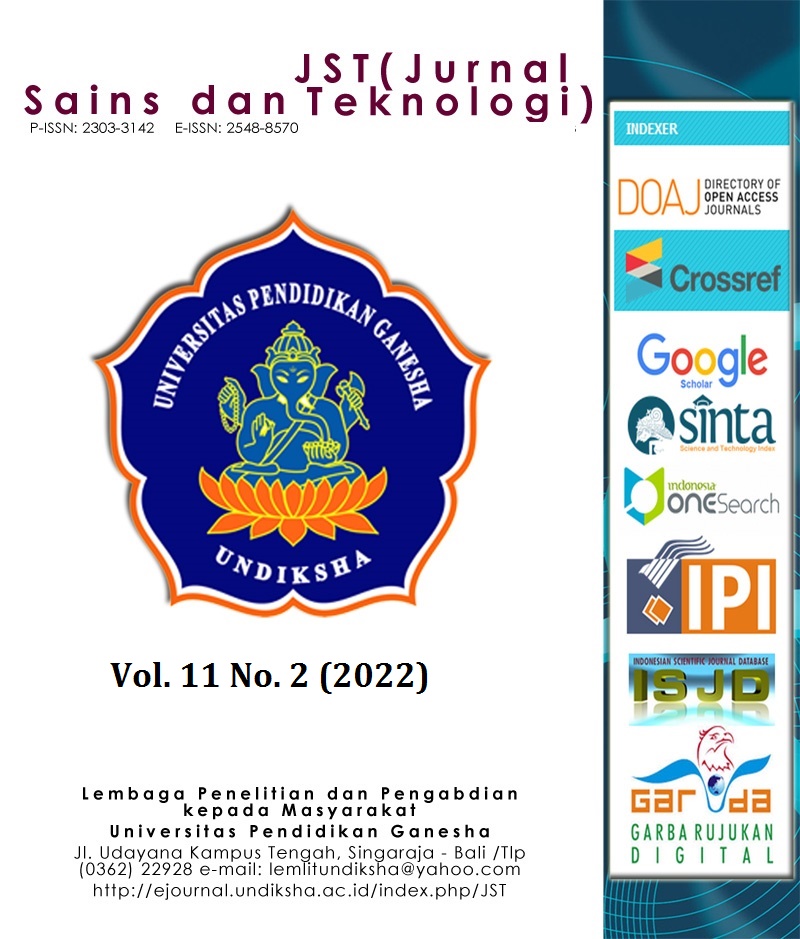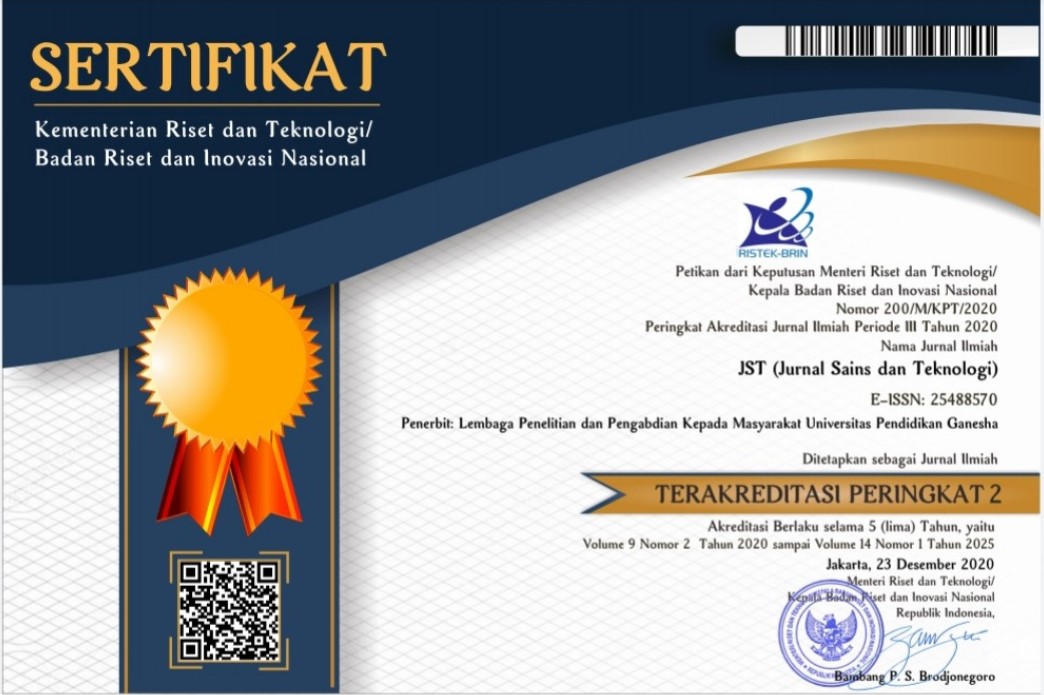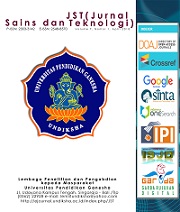MODEL SURVIVAL SEMIPARAMETRIK DAN PARAMETRIK UNTUK DATA DEMAM BERDARAH DENGUE (DBD) DI RSUD KABUPATEN CIAMIS TAHUN 2020
DOI:
https://doi.org/10.23887/jstundiksha.v11i2.43493Kata Kunci:
survival analysis, DHF, Cox PH, Breslow, Efron, exact.Abstrak
The research is about the best survival analysis model used for patients with Dengue Hemorrhagic Fever (DHF) at Ciamis Hospital in 2020. The purpose of this research is to identify the factors that influence the rate of cure for DHF at Ciamis Hospital in 2020. The method used is survival analysis. Furthermore, the parametric model used Weibull PH, whereas the semiparametric model used Cox PH regression. The result of the analysis showed that the best model obtained was the semiparametric Cox PH regression model, with significant factors including age, Pack Cell Volume (PCV), hemoglobin, White Blood Cell (WBC), and body temperature.
Referensi
Afify, A. Z., & Mohamed, O. A. (2020). A New Three-Parameter Exponential Distribution with Variable Shapes for the Hazard Rate: Estimation and Applications. Mathematics, 8(1), 135. https://doi.org/10.3390/math8010135.
Ahmad, T., Munir, A., Bhatti, S. H., Aftab, M., & Raza, M. A. (2017). Survival analysis of heart failure patients: A case study. PLOS ONE, 12(7), e0181001. https://doi.org/10.1371/journal.pone.0181001.
Aldahlan, M. A. D., & Afify, A. Z. (2020). The Odd Exponentiated Half-Logistic Exponential Distribution: Estimation Methods and Application to Engineering Data. Mathematics, 8(10), 1684. https://doi.org/10.3390/math8101684.
Ali̇, S., Dey, S., Tahi̇R, M. H., & Mansoor, M. (2020). A comparison of different methods of estimation for the Flexible Weibull distribution. Communications Faculty Of Science University of Ankara Series A1Mathematics and Statistics, 794–814. https://doi.org/10.31801/cfsuasmas.597680.
Amir, W. M., Azeem, M., Harun, M. H., Ali, Z., & Shafiq, M. (2020). JMASM 54: A Comparison of Four Different Estimation Approaches for Prognostic Survival Oral Cancer Model. Journal of Modern Applied Statistical Methods, 18(2), 2–14. https://doi.org/10.22237/jmasm/1604189760.
Asar, Ö., Ritchie, J., Kalra, P. A., & Diggle, P. J. (2015). Joint modelling of repeated measurement and time-to-event data: An introductory tutorial. International Journal of Epidemiology, 44(1), 334–344.
Atlam, M., Torkey, H., El-Fishawy, N., & Salem, H. (2021). Coronavirus disease 2019 (COVID-19): Survival analysis using deep learning and Cox regression model. Pattern Analysis and Applications, 24(3), 993–1005.
Bain, L. J., & Engelhardt, M. (1992). Introduction to probability and mathematical statistics (Vol. 4). Duxbury press Belmont, CA.
Borucka, J. (2014). Methods of handling tied events in the Cox proportional hazard model. Studia Oeconomica Posnaniensia, 2(2), 91–106.
Brembilla, A., Olland, A., Puyraveau, M., Massard, G., Mauny, F., & Falcoz, P.-E. (2018). Use of the Cox regression analysis in thoracic surgical research. Journal of Thoracic Disease, 10(6), 3891–3896. https://doi.org/10.21037/jtd.2018.06.15.
Breslow, N. (1974). Covariance analysis of censored survival data. Biometrics, 89–99.
Bustan, M. N., Aidid, M. K., & Gobel, F. A. (2018). Cox proportional hazard survival analysis to inpatient breast cancer cases. Journal of Physics: Conference Series, 1028(1), 012230.
Collett, D. (2015). Modelling survival data in medical research. CRC press.
Efron, B. (1977). The efficiency of Cox’s likelihood function for censored data. Journal of the American Statistical Association, 72(359), 557–565.
Emmert-Streib, F., & Dehmer, M. (2019). Introduction to survival analysis in practice. Machine Learning and Knowledge Extraction, 1(3), 1013–1038.
Fatekurohman, M., Nurmala, N., & Anggraeni, D. (2018). Comparison of exact, efron and breslow parameter approach method on hazard ratio and stratified cox regression model. 1008(1), 012007.
Fauziah, A. A., Budiman, Safitri, D. L., & Meiza, A. (2021). Survival analysis with the Cox Proportional Hazard Method to determine the factors that affect how long the Large-Scale Social Distancing (LSSD) will applied in various areas affected by the covid-19 pandemic. Journal of Physics: Conference Series, 1751(1), 012004. https://doi.org/10.1088/1742-6596/1751/1/012004.
Flynn, R. (2012). Survival analysis. Journal of Clinical Nursing, 21(19pt20), 2789–2797.
George, B., Seals, S., & Aban, I. (2014). Survival analysis and regression models. Journal of Nuclear Cardiology, 21(4), 686–694.
Gisondi, P., Cazzaniga, S., Di Leo, S., Piaserico, S., Bellinato, F., Pizzolato, M., Gatti, A., Eccher, A., Brunelli, M., Saraggi, D., Girolomoni, G., & Naldi, L. (2021). Impact of the COVID‐19 pandemic on melanoma diagnosis. Journal of the European Academy of Dermatology and Venereology, 35(11).
Guo, S. (2010). Survival analysis. Oxford University Press.
Hilbe, J. M. (2011). Negative binomial regression. Cambridge University Press.
Hughey, J. J., Rhoades, S. D., Fu, D. Y., Bastarache, L., Denny, J. C., & Chen, Q. (2019). Cox regression increases power to detect genotype-phenotype associations in genomic studies using the electronic health record. BMC Genomics, 20(1), 1–7.
Husain, H., Thamrin, S. A., Tahir, S., Mukhlisin, A., & Apriani, M. M. (2018). The application of extended Cox proportional hazard method for estimating survival time of breast cancer. Journal of Physics: Conference Series, 979(1), 012087.
In, J., & Lee, D. K. (2018). Survival analysis: Part I — analysis of time-to-event. Korean Journal of Anesthesiology, 71(3), 182–191. https://doi.org/10.4097/kja.d.18.00067.
Jung, S.-H., Lee, H. Y., & Chow, S.-C. (2018). Statistical Methods for Conditional Survival Analysis. Journal of Biopharmaceutical Statistics, 28(5), 927–938. https://doi.org/10.1080/10543406.2017.1405012.
Kleinbaum, D. G., & Klein, M. (2004). Survival analysis. Springer.
Kleinbaum, D. G., & Klein, M. (2012). Survival analysis: A self-learning text (Vol. 3). Springer.
Lánczky, A., & Győrffy, B. (2021). Web-Based Survival Analysis Tool Tailored for Medical Research (KMplot): Development and Implementation. Journal of Medical Internet Research, 23(7), e27633.
Lee, E. T., & Wang, J. (2003). Statistical methods for survival data analysis (Vol. 476). John Wiley & Sons.
Le-Rademacher, J., & Wang, X. (2021). Time-to-event data: An overview and analysis considerations. Journal of Thoracic Oncology, 16(7), 1067–1074.
Moolgavkar, S. H., Chang, E. T., Watson, H. N., & Lau, E. C. (2018). An assessment of the Cox proportional hazards regression model for epidemiologic studies. Risk Analysis, 38(4), 777–794.
Ozenne, B., Sørensen, A. L., Scheike, T., Torp-Pedersen, C., & Gerds, T. A. (2017). riskRegression: Predicting the risk of an event using Cox regression models. The R Journal, 9(2), 440–460.
Ross, S. M. (2014). Introduction to probability models. Academic press.
Schober, P., & Vetter, T. R. (2018). Survival Analysis and Interpretation of Time-to-Event Data: The Tortoise and the Hare. Anesthesia & Analgesia, 127(3), 792–798. https://doi.org/10.1213/ANE.0000000000003653.
Xie, Y., Han, J., Yu, W., Wu, J., Li, X., & Chen, H. (2020). Survival Analysis of Risk Factors for Mortality in a Cohort of Patients with Tuberculosis. Canadian Respiratory Journal, 2020, 1–9. https://doi.org/10.1155/2020/1654653.
Xin, X. (2011). A study of ties and time-varying covariates in cox proportional hazards model. University of Guelph.
Zhang, Z. (2017). Survival analysis in the presence of competing risks. Annals of Translational Medicine, 5(3), 47–47. https://doi.org/10.21037/atm.2016.08.62.
Unduhan
Diterbitkan
Cara Mengutip
Terbitan
Bagian
Lisensi
Hak Cipta (c) 2022 JST (Jurnal Sains dan Teknologi)

Artikel ini berlisensiCreative Commons Attribution-ShareAlike 4.0 International License.
Authors who publish with the Jurnal Sains dan Teknologi (JST) agree to the following terms:
- Authors retain copyright and grant the journal the right of first publication with the work simultaneously licensed under a Creative Commons Attribution License (CC BY-SA 4.0) that allows others to share the work with an acknowledgment of the work's authorship and initial publication in this journal.
- Authors are able to enter into separate, additional contractual arrangements for the non-exclusive distribution of the journal's published version of the work (e.g., post it to an institutional repository or publish it in a book), with an acknowledgment of its initial publication in this journal.
- Authors are permitted and encouraged to post their work online (e.g., in institutional repositories or on their website) prior to and during the submission process, as it can lead to productive exchanges, as well as earlier and greater citation of published work. (See The Effect of Open Access)
















